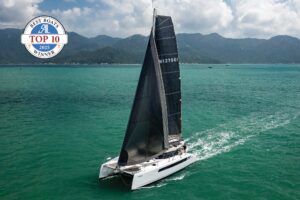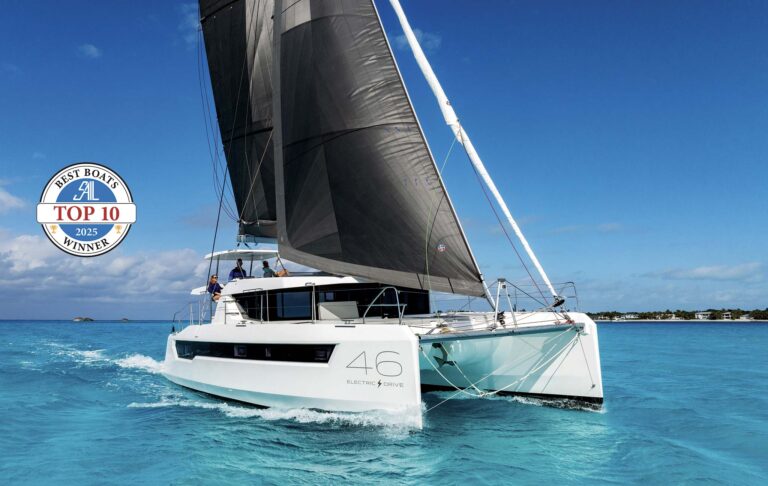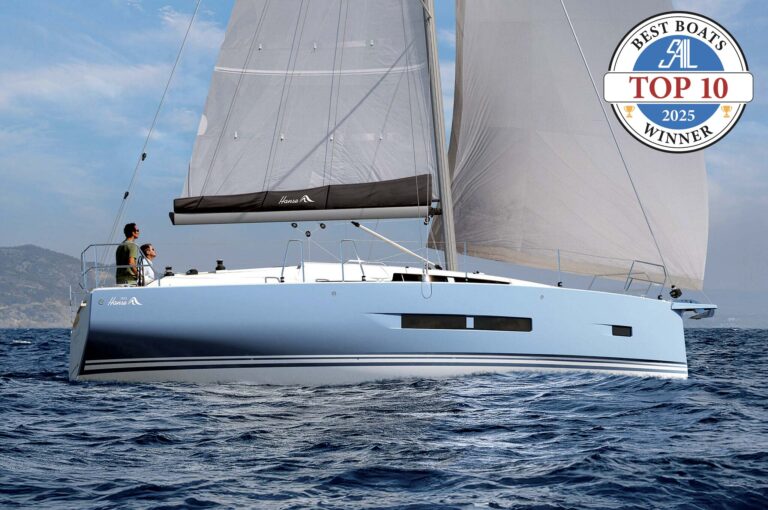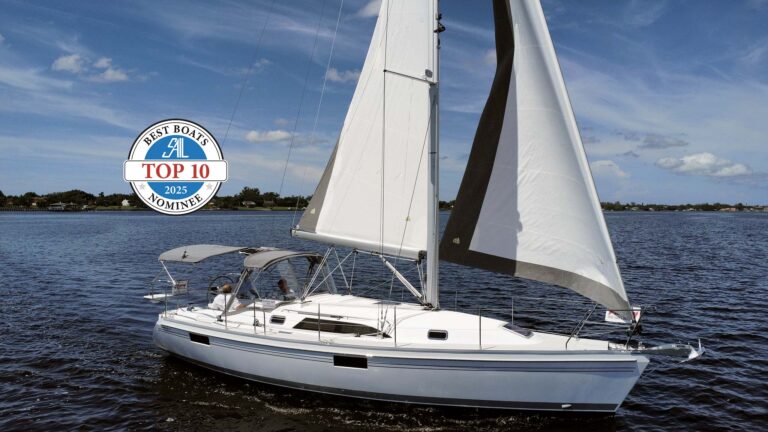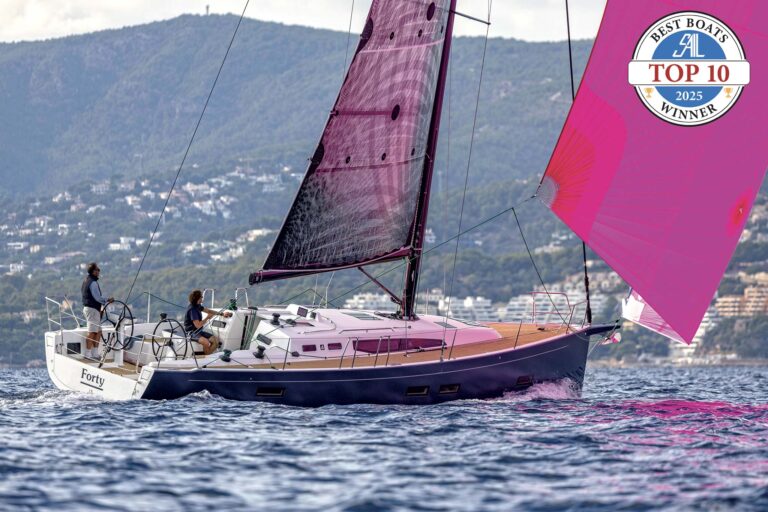That Beneteau is fully committed to coming out of the Great Recession with all guns blazing is amply demonstrated by the fact that it introduced not one, but two boats in its new line of Sense cruisers during the 2010-11 boat show season. This 43-foot offering doesn’t have as many bells and whistles as its big sister, the new Sense 50, but it does demonstrate that the Sense design concept can translate successfully into a significantly smaller hull.

Construction
The boat’s construction is entirely conventional. The hull is solid glass set in polyester resin. The deck is balsa-cored, and bonded and bolted to the hull. The ballast keel is cast iron. Finish quality is about average for a modern mass-production boat.
On Deck
All that separates the very wide cockpit from the saloon is three low steps. The companionway is enormous, so that traffic (and any boarding waves) can flow easily into the interior. The twin helm stations are pushed all the way aft (there is a collapsible sill to keep you from accidentally backing out of the open transom when stepping away from a wheel), so there is scads of space for socializing. The focal point is a collapsible table to starboard with wrap-around bench seating that converts to a sun bed.
All lines from the mast and boom are led aft to secondary winches on the forward end of the cockpit coamings, where they are easily accessible. There’s no traveler: instead, the main sheets to blocks on a large arch overhead. This arrangement works well, but I did miss being able to toss working lines down the companionway while sailing. The many lines coming aft are stuffed in two rather small line boxes in the coaming, and it is impossible to keep them neatly sorted. I’d also like to see a traveler on the mainsheet arch.
Perhaps the cockpit’s best features are the two enormous stowage lockers on either side. Big enough to easily swallow fuel jugs, sails, rolled up tenders and outboard motors, they should prove eminently useful to active cruisers. There’s even enough room to lay in a passage berth if you like, and the port locker has a fold-down vent beneath the hatch cover to facilitate this.
Accommodations
In conceiving these new boats, Beneteau and the Berret Racoupeau design group have bravely abandoned what has long been a central tenet of production cruising boat design. Instead of trying maximize stateroom and head space by cramming accommodations under the cockpit, they have instead focused on maximizing the key social spaces—the saloon and cockpit—and marrying them to each other as closely as possible.

On the Sense 43, the cockpit and saloon take up the aft two-thirds of the boat, and all the “sleeping rooms,” plus the one head, are situated in the bow. The saloon is very large and open, with sightlines, like those on a catamaran, leading outside the space in all directions. Large windows with integral opening ports face to starboard, to port and aft out to the cockpit. There are also small bulkhead windows forward that carry your gaze into the rest of the accommodation space.
The in-line galley is laid out to port behind a sturdy center island and has scads of counter space. The two sinks are a tad small and shallow, but there is lots of useful storage space along with a pair of excellent working areas on either side of the stove. The dinette and wraparound settee directly opposite are roomy and comfortable. For your evening entertainment there’s a large flat-screen TV that pops up out of the island facing the settee.
The nav station, which runs alongside the aft edge of the settee with a view through a window directly into the cockpit, is one of the best I’ve seen on a contemporary boat this size. The desk is quite long, with plenty of room for laying out charts and papers, and there is lots of room in the overhanging cabinets to install ancillary electronics.
The two staterooms forward seem perfectly functional and have good-size double berths. The guest stateroom to port, in my opinion, would work better with twin single bunk berths, as this would open up more floor space and make the boat an ideal vehicle for a couple with two children.
Under Sail
Like its big sister, the Sense 43 sails very well. The hard chines in the hull and the twin rudders allow for great directional stability, even when the boat is hard pressed. It also moves well in light-to-moderate wind with appropriate sails.
Our test boat carried a shoal-draft keel and was equipped with an in-mast furling mainsail, a self-tacking blade jib, and a gennaker on a continuous-line furler just forward of the headstay. In 10-12 knots of true wind off Miami Beach, we maintained 5.7 to 6 knots of speed sailing close-hauled in flat water at a 40 degree apparent wind angle. Cracking off to a close reach with the gennaker unfurled, our top speed increased to 7.6 knots. On a flat reach this dropped to 6.7 knots. On a broad reach, at a 135 degree apparent wind angle, it fell to 4.7 knots.
I found the helm to be smooth and well balanced. Sailing close-hauled with the sails trimmed properly I could keep my hands off the wheel for up to 10 minutes before the boat started slowly rounding up. Close reaching under the gennaker in nearly 15 knots apparent wind, there was light weather helm; on a broad reach the helm was neutral.
Under Power
The Sense 43, unlike its big sister, cannot be ordered with Beneteau’s new Dock & Go drive system, though a conventional bow thruster is available. During our test, the 43’s 54hp engine drove the boat in flat water to a speed of 6.5 knots at 1,800rpm and 9 knots flat out at 3,000rpm. The twin rudders provided good control when backing down, as long as rudder angles were kept relatively shallow.
Engine access, unfortunately, is somewhat compromised. For quick access the shallow companionway steps fold up in the conventional manner, but the engine is mounted far back in the space and isn’t easy to reach. Side access is through removable panels in the cockpit lockers. If you store much gear in those lockers, you’ll have some unpacking to do before you can pull the dipstick and check the oil.
Conclusion
The Sense 43 will be immensely appealing to those who want catamaran-style social spaces in a monohull boat that sails well and is easy to handle. Two couples or a family will be quite comfortable cruising the boat for extended periods. With its large cockpit, the Sense 43 can also accommodate a horde of guests during a long daysail.
Our Take
Pros
• Bright, spacious saloon
• Roomy cockpit
• Good stability and sailing performance
• Attractive styling
Cons
• No protection from boarding seas aft
• Less than optimal engine access
• No mainsheet traveler


